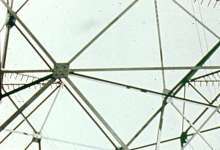Chronoma was conceived as a follow-up to Rythmes 76: its composition is still inspired by the repetitive processes of Steve Reich's music, with their gradual progression.
This time, we have a sequence of photographs taken with a motorized camera (a proto movie camera) in a circular movement around a high-voltage electric tower in northern Paris. The initial image is in itself a drawing of lines intersecting to form angles.
The sequence recomposes a clumsy but deliberate moving image effect, in the same vein as precursors of cinema as Etienne-Jules Marey's chronophotographs.
The cinema device recreates an almost fluid moving image from the photographic images, but this moving image is "truffled" with color planes on a black background, some kind of negatives of the photographic images, which disturb, create violent effects of light contrasts in fast rhythms: the famous flicker effect experienced by Brion Gysin's closed eyes with Ian Sommerville through the Dreammachine in 1962 but radicalized in cinema since Gil J Wolman, Peter Kubelka or Paul Sharits and from which subjects with epileptic seizures (neuronal rush) had to protect themselves. In the case of Chronoma, it is a question of grafting a moving image onto this "flicker", of synthesizing the continuous and discontinuous, the peaceful and the violent in order to achieve an increased awareness of visual phenomena.
JMB
4 PRINTS IN DISTRIBUTION
|
distribution format |
16mm |
|
screen |
1,37 (single screen) |
|
speed |
24 fps |
|
sound |
silent |
|
rental fee |
93,00 € |
|
distribution format |
16mm |
|
screen |
1,37 (single screen) |
|
speed |
24 fps |
|
sound |
silent |
|
rental fee |
93,00 € |
|
distribution format |
Digital file on USB stick (FHD) |
|
screen |
1,37 (single screen) |
|
speed |
24 fps |
|
sound |
silent |
|
rental fee |
93,00 € |
|
distribution format |
DCP on server (SMPTE 2K) |
|
screen |
1,37 (single screen) |
|
speed |
24 fps |
|
sound |
silent |
|
rental fee |
93,00 € |














